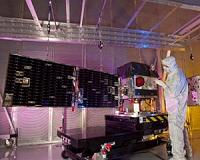 |
Paris, France (ESA) Aug 04, 2010 The Payload Module of ESA's latest meteorological satellite, MetOp-B, has been hauled out of the largest vacuum chamber in Europe: its ability to operate in the harsh conditions of space has been proved. After more than a month of testing in ESA's Large Space Simulator (LSS) at ESTEC in the Netherlands, MetOp-B's Payload Module was lifted out of the vacuum chamber on 28 July. The module hosts all of the sensitive meteorological instruments. It had been placed within the LSS to recreate space conditions down here on Earth. The largest simulator of its kind in Europe - big enough to accommodate a double-decker bus standing upright - the LSS subjected the module to space-quality vacuum and temperatures ranging from upwards of 100 degrees C down to 120 degrees below zero. "Some of MetOp-B's sensors work under much colder conditions still, because they are actively cooled for optimal performance verification," said MetOp programme manager Luciano Di Napoli.
Heavy lifting The MetOp-B team worked with ESTEC Test Centre personnel to prepare for the Payload Module's 'liberation'. The multi-layer insulation-covered module was lifted up out of the LSS slowly and with maximum precision. The mission team monitored every millimetre-scale movement until the satellite was safely on its stand in the adjoining clean room. The entire process took three hours to complete. After final checks at the ESTEC Test Centre, the module will be transported at the start of August to payload module contractor EADS Astrium, in Friedrichshafen, Germany, where it will be temporarily stored, waiting for the final precise calibration of some European and American instruments. Next year, it will journey to Toulouse, where EADS Astrium prime contractor will attach it to the Service Module and the solar panels. Finally, MetOp B will be transported to Baikonur in Kazakhstan for launch on a Soyuz rocket in the spring of 2012.
Ensuring continuous data "By launching a new satellite every five to six years, the MetOp system can provide continuous data for temperature, humidity, cloud cover and gases in the atmosphere, among other things," says Rob Oremus, project controller for MetOp. "These data are essential for operational meteorology and climate research." Mr Oremus was pleased with the results of the tests performed in the LSS: "The Payload Module is the most critical part of the MetOp-B satellite. It contains the instruments that will be collecting the data. "Now that the module has overcome the vacuum test, the path is clear for the run-up to the launch."
Share This Article With Planet Earth
Related Links MetOp Space Technology News - Applications and Research
 Ball Aerospace Ships STPSat-2 To Kodiak Launch Complex
Ball Aerospace Ships STPSat-2 To Kodiak Launch ComplexBoulder CO (SPX) Aug 03, 2010 Ball Aerospace and Technologies has shipped the STPSat-2 satellite built for the U.S. Air Force Space and Missile Systems Center, Space Development and Test Wing (SDTW) to Alaska's Kodiak Launch Complex for scheduled liftoff aboard a Minotaur 4 rocket for a fall 2010 launch. STPSat-2 is the first spacecraft for the Department of Defense (DoD) Space Test Program Standard Interface Vehicle ( ... read more |
|
| The content herein, unless otherwise known to be public domain, are Copyright 1995-2010 - SpaceDaily. AFP and UPI Wire Stories are copyright Agence France-Presse and United Press International. ESA Portal Reports are copyright European Space Agency. All NASA sourced material is public domain. Additional copyrights may apply in whole or part to other bona fide parties. Advertising does not imply endorsement,agreement or approval of any opinions, statements or information provided by SpaceDaily on any Web page published or hosted by SpaceDaily. Privacy Statement |